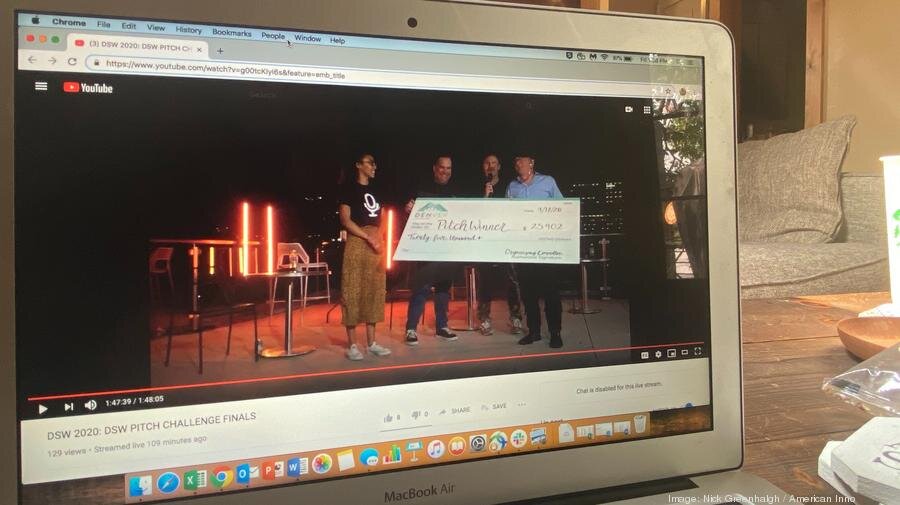4 Sales Presentation Skills That Can Earn You $100K
/Nick Greenhalgh / American Inno
How does a startup in Denver get a $100K for their great idea?
They serve up an exceptional pitch.
Well, there are a few other criteria as well. Like the startup’s great idea has to actually be great. And they have to serve up their pitch at the right time to the right people.
Few startups are likely to snag $100K for randomly sharing their pitch on YouTube. But one does get to go home with the grand prize if their pitch hits the mark during the annual Denver Startup Week’s Pitch Competition.
Fireless Cremation Systems won the 2020 Denver Startup Week Pitch finals by creating an environmentally-friendly alternative to traditional cremation. His innovative company has created a solution that allows bodies to be returned to the earth in a way that benefits the environment. Congrats Ed!
Ben Deda, DSW Co-Founder, giving Pitch Lab a sponsorship nod
What’s Denver Startup Week’s Pitch Competition?
Denver Startup Week (DSW) is akin to a week-long party hailing local entrepreneurs. People come together to engage in programs and events to celebrate innovation, ingenuity and yes, great ideas. It’s the largest free event of its kind, bringing together more than 20,000 people with more than 350 programs in 2019.
The heart of DSW is the Pitch Competition, where some of Denver’s hottest entrepreneurs take the stage to compete for a prize package worth up to $100,000.
The 2020 version of the annual event was virtual, and it was also the fourth year Pitch Lab was involved with DSW.
As Pitch Lab’s founder, I had the opportunity to give back and coach the 16 Pitch Competition semifinalists over Zoom. (Yeah, it was pretty fun.)
Leading up to the finals, over a two-and-a-half-week period, I gave each of the 16 semifinalists a private consulting session. Since I had the opportunity to see so many talented entrepreneurs present in such a short amount of time, it was easy to see some patterns emerge.
A few things really stood out to me about what separates a good presenter from a great presenter.
4 Presentation Skills that Transform Good to Great
1 – Great presenters open with a personal story to create an emotional connection between themselves and their business.
Can you remember the last great speech, or even the last great comedy show you attended? Probably not. But you can probably remember the basic plot of your all-time favorite movie.
That’s because the movie had a story. Stories are memorable, stirring up empathy and emotional connections. We’ll remember an emotional personal story about starting a business. But we’re unlikely to remember other facts and figures related to the business unless they create some type of emotional response.
2 – Great presenters speak authentically instead of memorizing a script.
When you’re solely focused on getting the words of the script just right, you’re missing out on what’s going on in the moment. You’re also likely to come across as a robot, spewing out memorized words in perfect order.
As I’ve said before, your audience doesn’t care about perfection. They just want connection.
Speaking authentically from the heart is more likely to create that connection they crave.
3 – Great presenters prepare less content than time allotted to pitch – to allow for improvisation and organic conversation.
Not every single tidbit of information is important. That means you don’t have to cram 45 minutes of material into a 30-minute pitch.
Stick with the most important info, giving your audience time to absorb, react and enjoy what they’re learning. This also gives you time to interact, improvise and – you guessed it – create a greater emotional connection.
4 – Great presenters know the difference between a “pitch deck” and a “leave behind deck.”
A pitch deck is a collection of slides that you deliver in real time. It’s mostly imagery with very little text. Its job is to support and enhance what you’re saying at the moment.
A leave-behind deck is also a collection of slides, but the slides here contain a mix of imagery and text – and way too much information to be a background part of a presentation.
A leave-behind deck is fine for people to read at their leisure, but not while you’re presenting. Your audience can’t read the text on your slide and listen to you talk at the same time.



